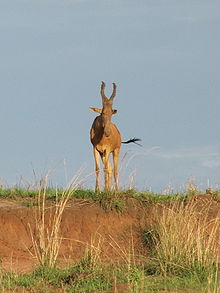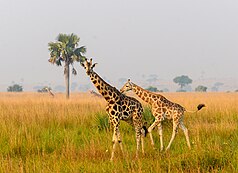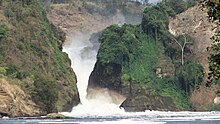Murchison Falls National Park
| Murchison Falls National Park | ||
|---|---|---|
| Rothschild giraffes in Murchison Falls National Park | ||
|
|
||
| Location: | Uganda | |
| Next city: | Masindi | |
| Surface: | 3,877 km² | |
| Founding: | 1954 | |
| Address: | Murchison Falls National Park | |

The Murchison Falls National Park is a national park in northwestern Uganda . It has an area of 3877 km² and is 500 to 1292 m above sea level. The driveway is about 230 km from Kampala .
Territory, flora and fauna
The park covers the largest single protected area in the country. Together with the adjacent game reserves of Bugungu (473 km²) and Karuma (675 km²), which are 600 to 1,300 m above sea level, the Murchison Falls Conservation Area covers an area of 5,025 km².
The savannah (grassland) in the north of the park is populated by typical species such as lions , African buffalos , elephants , Uganda kobs (an antelope species common in Uganda ) and, as a specialty, the rare Rothschild giraffe . In the south there is mainly dry forest . The west is dominated by hilly grassland and papyrus swamps, the eastern tree savannah is separated from the grass savannah by dense forest. The park is named after the Murchison waterfall . There the Victoria Nile , which belongs to the White Nile , plunges in an impressive manner with a 43 m drop over a step after it has squeezed through a narrow point of the East African Rift and flows into the Albertsee , which it leaves again in a northerly direction. The Victoria Nile thus forms the western border of the national park at this point. Under the Murchison waterfall, there are Nile crocodiles that also feed on animals that fell victim to the waterfall, hippos and many birds. The rare shoebill can also be found there.
In the southeast of the park lies the Budongo Forest (Bodongo Forest Reserve), in which typical rainforest inhabitants and, above all, several groups of chimpanzees live.
history
The Bunyoro Wildlife Reserve as part of the park was established as a game reserve in 1910. The originally sparsely populated area around the Murchison Falls was evacuated by the British colonial administration from 1930 after a renewed outbreak of sleeping sickness in order to contain the spread of the disease, as there are numerous tse-tse flies in the entire area . Only then did the idea of a wildlife park and the protection of the impressive natural landscape (immediately around the falls) arise. In 1954 the reserve became Murchison Falls National Park. In the period from 1960 and before Idi Amin's takeover , the park was one of the most popular tourist destinations in East Africa , and the luxurious lodge in Paraa did not have to shy away from comparison with other luxury accommodations in the region.
After the beginning of the dictatorship of Idi Amin Dada, the park was renamed Kabalega National Park ( Kabalega Falls National Park ) in 1972. At the same time, corrupt officers took power in the park, the elephants were slaughtered by the hundreds with machine guns to "obtain" ivory , and other animal species, especially lions and leopards, were hunted to almost extinction because of their furs and trophies. The population numbers of elephants dropped from 14,309 copies in 1973 over 6030 in the next year to 2,246 in 1975. The once coexisting Spitzmaul- and white rhinos have been exterminated. While in the 1960s the overly large elephant population caused severe damage to trees and bushes, with some incipient desertification and erosion of the previous bushland, especially north of the Nile, the large areas were then almost completely free of larger vertebrates. Until the late 1990s, the West Nile Province was considered a trouble spot in which various rebel groups, in particular the so-called Lord's Resistance Army with their child soldiers , were active. From the end of the 1990s, the tourist infrastructure was established and expanded.
Accessibility and security
The park can be reached from Kampala in about 5 hours by car via Luweero - Nakasongola - Masindi (asphalt road to Masindi) or from the north via Pakwach . No 4x4 is necessary to drive to the park; An all-terrain vehicle is recommended for game drives in the park. There are several international standard lodges in the park as well as simpler hostels and campsites. Security problems caused by robberies have not existed for years. In the park, however, there is a low risk of infection for sleeping sickness from bites of the tse-tse fly.
Landmarks in the park
These include the falls themselves, which can be hiked from a rest and camping site above the falls or explored from Paraa with a boat trip to the foot of the falls (there you can get out on a small rock in the middle of the river). Game drives can be undertaken on well-maintained slopes; Bringing a gamekeeper is not compulsory, but advisable.
present
The wildlife population is as high today as it was in the park's prime. On game drives, giraffes, elephants, lions and buffalo as well as various antelope species, monkeys, hippos, crocodiles and warthogs can be spotted regularly; with a little luck you might meet a leopard. The bushland has grown up again and the desertification process has been reversed in large areas. Several thousand tourists now visit the park every year. Major oil discoveries in the Albertgraben area have led to the construction of a large road with a bridge over the Victoria Nile through the middle of Murchison Falls National Park.
Miscellaneous

Already Winston Churchill had the idea to build a bridge over the falls during a visit in the 1920s. The only possibility of a paved crossing over the Nile was created in 1961 in the form of a footbridge directly at the upper edge of the falls. This was washed away 14 months later in a flood in 1962. Since the bridge had impaired the spectacular panorama both from above and below (it would be included in every photo of Murchison Falls from almost every perspective ), it was not renewed, although the concrete supports anchored in the rock are still there today and one make a stable impression.
Web links
- Uganda Wildlife Authority: Murchison Falls National Park (English)
- Uganda Tourism Board: The Murchison Falls (English)
literature
- Wally and Horst Hagen: The African national parks as habitats for elephants . In: Vitus B. Dröscher : Save the elephants of Africa . 1st edition. Goldmann Verlag , Munich 1992, ISBN 3-442-12322-4 . Pp. 246-247.
Individual evidence
- ↑ Safety instructions Uganda . Ministry of Foreign Affairs. April 4, 2019. Retrieved April 29, 2019.



